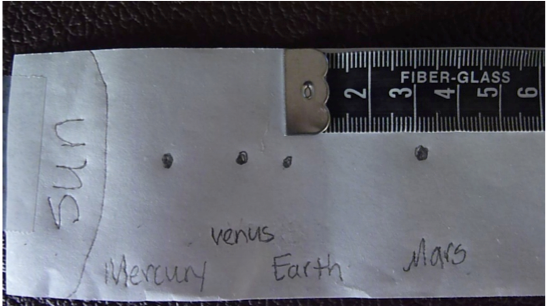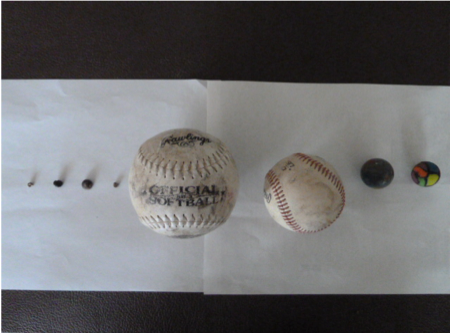Accurate Planet Distance and Size
Summary
Accurate planet size and distance from the Sun is studied in this lesson. Each student constructs a correctly scaled diagram of our solar system on adding machine paper. They learn facts about each planet and take a planet quiz. Finally, students use surface gravity information to determine which planet would give them the best workout.
Materials
Attachments
-
5lbweightandgravitycalculation.pdf
Five Pound Weight Calculation -
Planetactualandscaleddistancesfromsun.pdf
Planet Distances From Sun -
Planetdiametersandsurfacegravity.pdf
Planet Diameters -
planetfacts.pdf
Planet Facts -
planetpictures.pdf
Planet Pictures -
SunandPlanetQuizanswerkey.pdf
Quiz Answers -
SunandPlanetsQuiz.pdf
Sun and Planets Quiz
Planet distances and size activity:
- adding machine paper, 2 m per student, can be purchased from any office supply store
- tape
- sewing measuring tape, one per student if available
- colored pencils or crayons
- orange or yellow paper, cut out a Sun for each group, diameter 69.5 cm
- snack size Milky Way for treats (optional)
- Place one item for each planet in a bag for each group, or make one bag to be shared between all the groups.
Use the 'Scaled Diameter' column on the data table to check the sizes of objects.
These objects are approximately correct for their size. Feel free to substitute other objects you may have that are also accurate to size. - Softball - Jupiter
- Baseball - Saturn
- Two small seeds -- Mercury and Mars (Mars is slightly larger)
- Two different sized bouncy balls -- larger one is Uranus and smaller is Neptune
- Chocolate chip - Earth
- Dried blueberry or object slightly smaller than chocolate chip - Venus
- 5 lb. hand weight (optional) Builds prior knowledge for Standard 3 Objective 3 Section b
Background for Teachers
The Sun is the star for our solar system. It is much larger than any of the 8 planets that orbit it. Pictures or posters of our solar system are generally too small to accurately depict the correct scale for distances between the planets as well as the planet sizes compared to the Sun. Making correctly scaled models of the solar system ensures that students understand the vastness of our solar system and the different sizes of the planets.
The order of planets from the sun is easily remembered with this mnemonic: My Very Excellent Mother Just Served Us Nachos (Please used to stand for Pluto). The first four planets; Mercury, Venus, Earth, and Mars, are the terrestrial planets. These planets are made of rock and are close to the Sun, relatively small, and similarly sized. The next four planets; Jupiter, Saturn, Uranus, and Neptune, are the gas planets. These planets are made of gas with icy cores, larger, and much farther from the Sun than the terrestrial planets.
Gravity is the force of attraction that keeps the planets and moons in orbit. Gravity exists between any two objects but isn't noticeable unless at least one of the objects is very large. The planets orbit around the Sun because the Sun is much larger than the Earth. Our Moon orbits around the Earth because it is smaller than Earth. Weight is a measure of the pull of gravity on an object. A stronger pull of gravity will translate into a larger weight. That is why on smaller planets than Earth, we weigh less; on larger planets than Earth, we weigh more.
Intended Learning Outcomes
1. Use Science Process and Thinking Skills
c. Given the appropriate instrument, measure length, temperature, volume, and mass in metric units as specified.
3. Understand Science Concepts and Principles
a. Know and explain science information specified for the grade level.
4. Communicate Effectively Using Science Language and Reasoning
b. Describe or explain observations carefully and report with pictures, sentences, and models.
d. Use reference sources to obtain information and cite the source.
e. Use mathematical reasoning to communicate information.
Instructional Procedures
Pre-lab discussion:
Find 3 or 4 posters or models of our solar system. Have the students look at them and discuss what is correct and/or wrong about each one. Usually what is wrong is the size of the planets relative to each other and the Sun, or the distance between each planet. Discuss what a correctly scaled model is and tell the students they will make one today. Explain that gravity is what holds our solar system together and describe its effect on the weight of objects on each of the planets.
Activity 1: Planet Distances from the Sun and Relative Sizes
Students will map out relative planet distances on adding machine paper. After mapping out the distances they will draw the planets onto the paper using their approximate scaled sizes. Finally, they will color the planets their appropriate colors. As students are working, they will learn facts about each planet and finally take a quiz.
- Cut off 2 meters of adding machine paper. Tape the ends to a table, counter, or floor.
- Use a pencil to make a ) on the left end to represent the Sun. Give each student a "Planets Actual and Scaled Distances From the Sun" data table.
- Using a sewing measuring tape, each student measures out from the Sun and marks a dot in the center of the paper where each planet will be located. If you are using the measuring tape use the column on the data table that lists the 'scaled distances from the sun'. Students can just put one dot at each point down the tape. If using rulers, it may work to use the column on the data table that lists the 'distance from previous planet'. Either way works.
- At each dot, write the planet name at the bottom of the tape.

- As students make their marks and write in each planet name, have them look at the picture of each planet. Have an adult or student read the planet facts about each planet as they complete their drawings.
- Use the data table titled, "Actual and Scaled Sizes of the Sun and Planets with Surface Gravities" to draw in the planets over the dots. Be sure and explain to students what diameter is and that they should draw each diameter line over the dot and then fill in the circle that fits that diameter. Notice -- Jupiter won't completely fit on the tape.
- After the circles are all drawn for the planets, use crayons or colored pencils to color the planets appropriately with the information given. For the Asteroid Belt, students can draw in a line of small circles that represent asteroids in the belt.

- When students have finished drawing in all the planets and listened to the planet facts, have each student take the planet quiz. When they pass the quiz, they each receive a "Milky Way".
- Finally, place the large orange paper Sun over the ) on the adding machine tape. Students will now see the entire solar system for scaled sizes and distances, the 'wow' moment!
Students use the data table titled, "Actual and Scaled Sizes of the Sun and Planets with Surface Gravities" to complete this activity.
- Give each group of students a bag containing the planet objects.
- Students should study the table listing the scaled diameters of the planets.
- Students then decide which objects would match each planet for scaled size and lay them out along one of the students' adding machine paper solar systems. They should include the large orange paper Sun as well.
- When finished, they should have the teacher or other adult check off that the planet objects were placed correctly.
- Sun -- orange paper circle about 70 cm in diameter
- Mercury - seed
- Venus - dried blueberry, slightly smaller than the chocolate chip
- Earth - chocolate chip
- Mars - seed, slightly larger than Mercury's seed
- Jupiter - softball 
- Saturn - baseball
- Uranus - bouncy ball, slightly larger than Neptune's bouncy ball
- Neptune - bouncy ball

Activity 3: How much would a 5 lb. weight weigh on each planet?
Decide which planet would give students the toughest workout if they were lifting weights. An object's mass doesn't change from planet to planet but its' weight does. Weight is the force on an object due to the gravity that is pulling on it. The larger the mass of a planet, the stronger its gravitational pull, and the more an object weighs on that planet. Therefore, lifting a 5 lb dumbbell on Mercury will be much easier than lifting a 5 lb dumbbell on Jupiter.
- Use the data for the relative surface gravity of each planet found on the data table. Notice that for the terrestrial planets, their relative mass and surface gravity follow the same trend. For the gas planets, the trend is not always directly correlated because their densities can be very different.
- For each planet, calculate what a 5 lb weight would weigh on that planet (or the child's weight if they want).
Formula:
Weight x surface gravity factor = weight on new planetFor example:
 Jupiter: 5 lb x 2.53 = 12.65 lb - Have students show their work and calculate the new weight on the weight calculation page.
- Have students explain at the bottom of the page, which planet they would want to work out on and why.
Strategies for Diverse Learners
ELL/SPED- Partner with a group for the assessment or a pre-made worksheet that can be filled in to show understanding. Gifted - Find the distance and the size on their own using the provided chart.
Extensions
Assessment Plan
Final Assessment - Have each group create a poster with detailed labels accurately showing what knowledge was gained in relation to the distance and size of the planets from the sun. This can be done as a group. Give each person in the group the opportunity to evaluate the other members to ensure participation. Option two: Have the students measure the length of the hallway, then determine the distance between each planet at that scale and the size at that scale.
Bibliography
In partnership with Rio Tinto, this lab was originally written and compiled at Indian Hills Elementary School by the science educator and later expanded and revised at Beacon Heights Elementary School.
Rio Tinto Hands-on Science Curriculum Team
- Ms. Rae Louie -- Administrator, Principal Beacon Heights Elementary
- Emily Mortensen -- Grant writer, teacher outreach, 2nd grade teacher at Beacon Heights Elementary
- Ruth Li -- Curriculum design, K-6 Science Educator at Indian Hills Elementary
- Deirdre Straight -- Curriculum development, K-6 Science Educator at Beacon Heights Elementary
- Tim Rausch -- Website development, Library Media at Beacon Heights Elementary
Updated: 02/04/2018


 UTAH EDUCATION NETWORK
UTAH EDUCATION NETWORK

 Justin
Justin Braxton
Braxton Dani
Dani Kayla
Kayla Katie
Katie Matthew
Matthew Rob
Rob Val
Val
